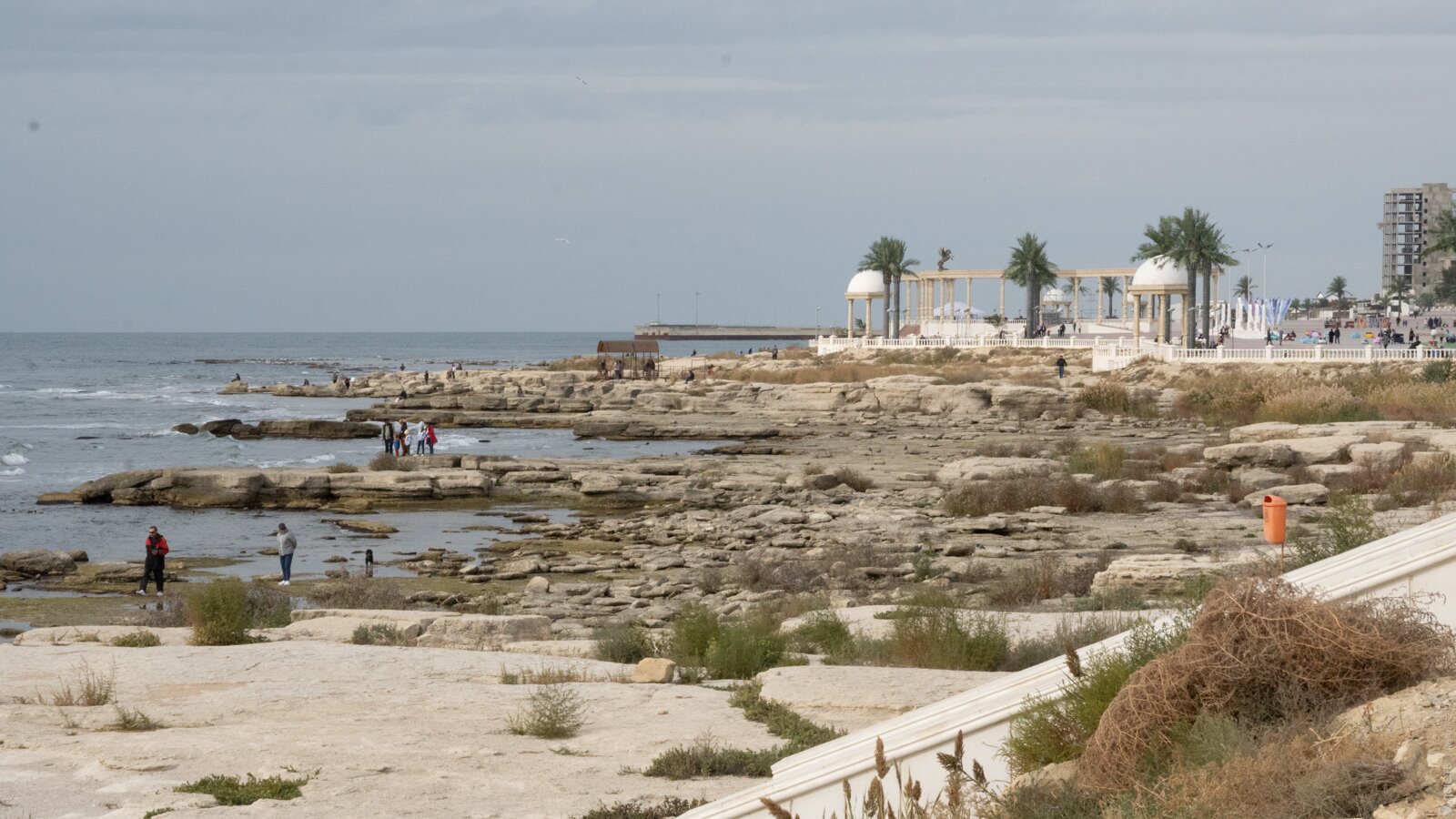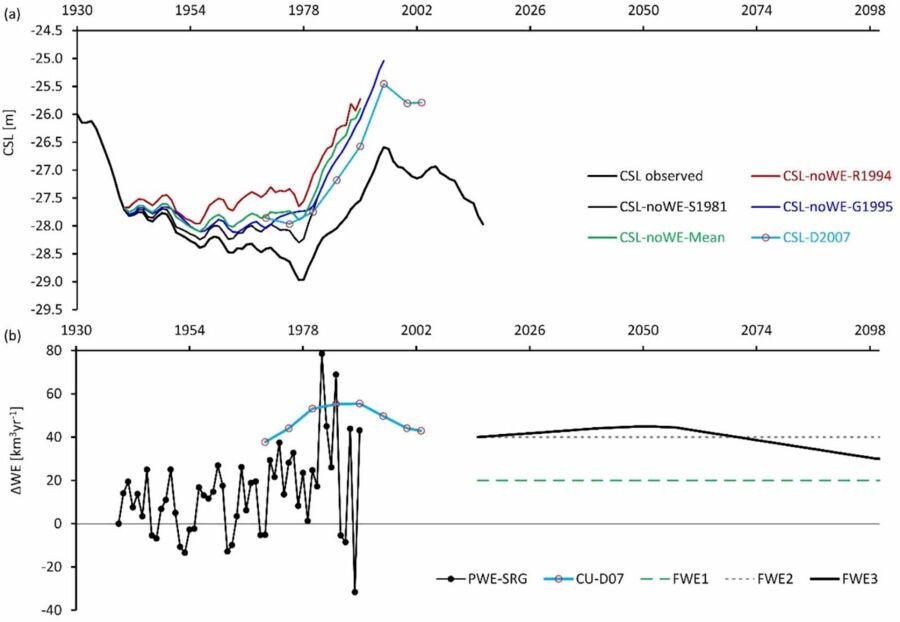Two of the foremost experts on water and climate in the Caspian region, Sifan Koriche at Baylor University in Waco, Texas, and Vadim Yapiyev, a scientist at Nazarbayev University in Astana, joined Vlast in a conversation about the falling water level in the Caspian Sea, the impact of human water extraction, and the consequences for the regional and global climate.
The researchers noted the importance of considering the Caspian as part of a larger ecosystem, spanning the whole Volga River basin and beyond. The decline of the water level is ongoing, according to a number of scientific studies, and estimates fluctuate between five and seven meters in the next decades. This will have a massive impact on the northern Caspian region and is poised to negatively affect the environment and living conditions especially in Kazakhstan’s section of the sea.
Koriche and Yapiyev also considered the crucial role of regional and global monitoring of large lakes, because of their widely underestimated role in affecting the world’s climate.
Yapiyev: Dr Koriche, please start us off by giving us context about the Caspian Sea basin.
Koriche: The Caspian Sea is the world’s largest inland lake, yet its designation often sparks confusion, leading to questions about whether it should be classified as a sea or a lake. It can be described as ‘a lake with a notable degree of salinity’. Over the course of days and millennia, the water level of this vast water body has undergone significant fluctuations. These fluctuations have had profound consequences, impacting the livelihoods of coastal communities and influencing industrial development across various sectors, ranging from fisheries to the oil industry. Changes in the Caspian Sea, particularly in the shallow northern part, have implications for coastal communities and conservation of marginal environments at the edge of the lake. This part of the lake is vulnerable to both climatic and anthropogenic influences, which is of particular concern to Kazakhstan, as over one-third of the coastal area within the shallow northern region falls under Kazakhstan's jurisdiction.
We can try to compare the northern part of the Caspian to the case of the Aral Sea, which has experienced a dramatic desiccation over the past century. Although the Caspian Sea might not undergo desiccation on the same scale as the Aral Sea, we should be concerned especially about the northern part.
Caspian Sea level variation is unique in nature and its evolution is complex, with water levels fluctuating from tens to hundreds of meters across various time scales due to the various driving processes and the environmental setting within its closed basin. Besides long term changes, current variations in the Caspian Sea's water level are primarily influenced by changes within the Volga River basin, contributing over 80% of the runoff and evaporation within the lake itself. Additionally, human intervention and tides also play a significant role, with tidal impacts leading to substantial changes in the range of a few centimeters to approximately four meters within a matter of days or weeks, which can pose significant challenges for those constructing industrial infrastructure and other ecosystem services.
Yapiyev: It is well known that the Volga river discharge contributes about 80% of the water input into the Caspian Sea. In the Soviet period, the construction of dams contributed to the decline of the level of the Caspian. However, the level suddenly grew again, and there is a lack of scientific explanation for this trend. A new paper by Samantha Petch et al. argues that the water storage in the Caspian Sea basin is primarily controlled by the changes in precipitation. How do you explain this trend? Is it because of climate change? Is it also aggravated because of these obstructions such as dams and other infrastructure? Can we pinpoint the key causes of this precipitation change?
Koriche: Changes in precipitation patterns within the Volga basin have significant impact on the Caspian Sea. Additionally, the construction of dams, designed primarily to enhance irrigation, has yielded significant consequences. These dams not only redirect water flows but also elevate the rate of evaporation. Given that the Caspian Sea is a closed basin without any outlets, the evaporation rate holds immense importance in governing fluctuations in its water levels.
The dams constructed during the Soviet era were implemented gradually, resulting in delayed repercussions for the Caspian Sea. Once all of these dams were in place, a distinct trend of "natural" variability emerged. It may take time to notice changes of atmospheric circulation, because this is a large basin, which covers different climatic zones. Presently, human water extraction practices also play a significant role, further exacerbating the deviations from natural variability.
Yapiyev: Is water extraction mostly attributable to human activities? In other words, what is the impact of anthropogenic extraction?
Koriche: The Caspian Sea is a transboundary catchment, so it is difficult to exactly find the proportion of water that is extracted for domestic activities or industrial purposes. There are some estimations of water use, but the combined impact is certainly anthropogenic [Figure 1 below]. Although the data shows that the impact is lower than the natural variability, the lack of coordinated management strategies by riparian states ultimately has a negative effect on water level variations.
Yapiyev: Some calculations show that for the Caspian Sea evaporation has had a larger impact on lake level variations than changes in precipitation. And if we look at the Great Lakes in North America, climate variability and change has had a larger impact than direct anthropogenic impacts such as land use and water extraction. Recently, we have witnessed water levels rise in the Great Lakes. Could it be that the warming of the Arctic and the consequent change in precipitation is also having an effect on the Volga basin and on the Caspian Sea?
Koriche: Your hypothesis is right. And while it is a complex system that does not allow us to attribute variability to one cause, the effect of the blocking from the Urals ridge on atmospheric circulation has been noticeable.
Yapiyev: This is also paired with a long-running drought in West Kazakhstan, especially with reduced flows from the Ural river.
Koriche: When considering this matter, it is essential to factor in the rate of moisture transport towards the east, across the vast territory of Kazakhstan. This phenomenon can be linked to the declining water levels within the lake basin as moisture migrates away. Furthermore, a critical aspect to address is the phenomenon of over-lake evaporation [the evaporation directly above the lake’s surface - ed.], which offsets all the inputs originating from the catchment area and precipitation over the sea. In the long term, there is a notable expectation of a decrease in the water level of the Caspian basin, an opposite trend compared to the average increase in global sea level.
Yapiyev: How does the Caspian Sea impact global climate, according to your studies?
Koriche: The size of the Caspian Sea has varied considerably over recent centuries and millennia due to various factors, including changes in climate. In our study we used a state-of-the-art climate model in which we specified different sizes of Caspian Sea in order to examine how the climate changes as its area increases. Our study found that as the Caspian Sea's area increases, there are substantial changes in the regional atmospheric water balance. Evaporation over the sea increases with a larger area, while precipitation increases over the south-western Caspian Sea. A larger Caspian Sea results in lower summer surface air temperatures and higher winter temperatures. These impacts extend eastward, leading to enhanced summer precipitation in Central Asia and warming in the north-western Pacific with reduced winter sea ice. Our findings demonstrate that changes in the Caspian Sea's size have significant climate impacts that should be considered in climate model simulations, including scenarios involving the past and future.
It is worth noting that the Caspian Sea can also impact the climate of the Northern Hemisphere. Changes in moisture flux to Central Asia can create a feedback loop affecting the Caspian Sea's hydroclimate.
Yapiyev: The current public discourse looks at the diminishing water level as a dramatic change, but analyzing a longer geological timeframe allows us to have a wider perspective. You looked at how the basin has changed in the past 2.6 million years, the Quaternary period.
Koriche: The Caspian Sea is currently an independent lake, but it was once part of a larger body of water known as Paratethys. A series of events, including geological changes and tectonic shifts, resulted in its separation from other basins, which are now occupied by the Black Sea and Mediterranean Sea. Unlike the Black Sea, the Caspian Sea became isolated from the surrounding marine environment, leading to its present configuration.
But this was not always the case. There was a time when there was a connection to the sea environment, which had an implication for the flora and fauna. Iconic species like the sturgeon, along with various fish and mollusks, have been profoundly influenced by these historical cycles of connection and disconnection from the marine environment. These fluctuations in environmental conditions have played a crucial role in shaping the Caspian Sea's unique ecosystem over time.
Going forward, we looked at what happens in the future, provided the current anthropogenic impact, as well as the predicted future climate. During the historical period, the impact of climate change and human extractions from the Caspian Sea basin had considerable impact on Caspian Sea level variation. Starting from the first sizable anthropogenic impact in the 1950s, the Caspian has dropped by at least 1.5 meters. This is huge, especially if you plot this into the future and add its effect on changing climate. At an average of 6 meters of depth, the shallow northern part of the Caspian Sea is at clear risk of desiccation by the end of the 21st century, according to our models. This would lead to severe impacts on biodiversity, ecosystems, economies, and geopolitical situations of the surrounding countries.
In the scientific community, there is a unanimous consensus that the Caspian Sea is experiencing a continuous decline [Figure 2 above]. Any short-term fluctuations in water levels in the coming decades would not indicate that this decline has stopped. This is why it is imperative to establish a coordinated approach for defining water rights and allocating quotas for domestic and industrial purposes. What is truly needed is a collective, regional, and global endeavor, recognizing the intricate interplay between the Caspian region's impact on global climate change and vice versa.
Kick-starting a global-scale project for monitoring large lakes would provide valuable insights into their influence on regional water budgets for neighboring countries, facilitating more informed decision-making and sustainable management practices.
Note: the interview was edited and shortened for clarity.
Поддержите журналистику, которой доверяют.













